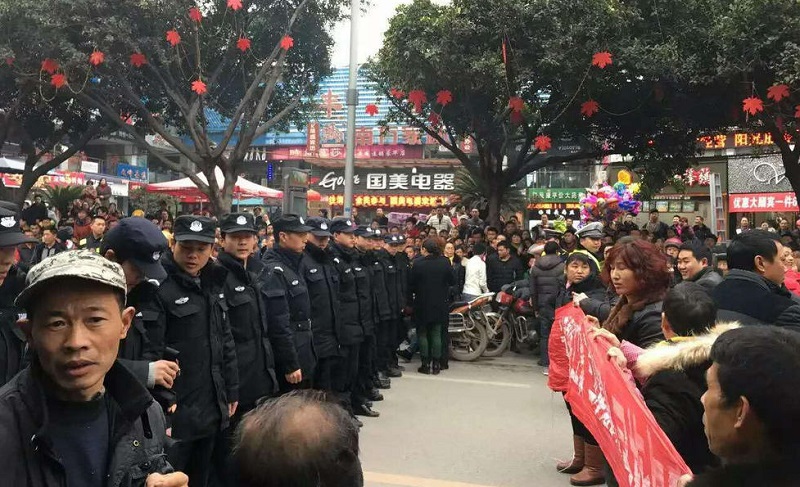The extent of China’s chronic wage arrears problem became clear in the run up to the Lunar New Year as workers all over the country staged protests in a bid to get paid before the 8 February holiday.
Between 1 December and 8 February, CLB’s Strike Map recorded 1,050 strikes and collective protests by workers, about 90 percent of which were related to the non-payment of wages.
The highest concentration of unrest was in Guangdong, Henan, Shandong and Hebei, with multiple protests by construction workers occurring in several major cities such as Zhengzhou (23 incidents) and Chengdu (21 incidents). Beijing, Guangzhou and Chongqing all had 14 construction worker protests in this period.

Construction workers in Chongqing demanding payment of wages face off against police on 28 January 2016. Photograph RFA
The construction industry, in which the non-payment of wages is an endemic and systematic problem, accounted for about 55 percent of all protests between 1 December and 8 February. Manufacturing accounted for 23 percent of the strikes and protests in the pre-New Year period and mining 5.6 percent, up from 4.0 percent during 2015 as a whole.
Given the Chinese government’s stated plans to lay off 1.8 million workers in the coal and steel industries alone over the next few years, there is a danger that the number of worker protests in these industries will only increase.
The well-documented problems of China’s shrinking manufacturing sector were reflected in the number of worker protests related to factory closures. The garment and shoe industries have been particularly badly affected and accounted for 40 percent of all factory closure and relocation disputes in the run up to the New Year holiday.
Even before the New Year surge in wage arrears protests, the Ministry of Human Resources and Social Security admitted there was huge wage arrears problem in China and that it was only getting worse. The Ministry reported in November last year that there had been 11,007 “incidents of migrant worker wage arrears” (发生涉及拖欠农民工工资问题的突发事件) in the first three quarters of 2015, an increase of 34 percent over the same period in 2014.
The Ministry also noted that wage arrears were no longer confined to the construction industry but had spread to manufacturing and the extractive industries as well.
Although not explicitly stated, it seems that the “incidents” referred to by the Ministry are collective protests, which would indicate that CLB’s Strike Map records around 12 percent of all worker protests in China. The Strike Map, which relies primarily on data from social media in China, recorded 1,350 wage arrears protests in the first three quarters of 2015.
